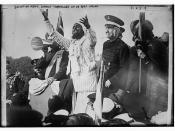The purpose of this paper is to define the most important force management challenge the new administration will face after entering office in 2009 and explain what they should do about it. Prior to September 11, 2001, no one would have predicted that seven years later, the United States Army would be engaged in two low-intensity, protracted wars fighting insurgents in the cities of Iraq and terrorists in the mountains of Afghanistan at the same time. During the Cold War era of the 70s, 80s, and early 90s, all of the United States' strategy objectives focus on stopping the Red Army as it rolled across the plains of Eastern Europe. Military leaders recognized that the way the Army would fight in the future had changed from large conventional conflicts against other nations to small unconventional warfare against rogue states and sponsors of terrorist groups. As a result, military planners have developed new doctrine that required the Army to be prepared to wage a full range of military operations along a broad spectrum of armed conflicts.
These fundamental changes in doctrine represented a shift in the way Army forces are managed. The two most important force management challenge to the new administration will face is personnel and equipment. In order to over come these force management challenges, all the new administration has to do is to provide the funding and oversight for the programs already in place to fix the problems.
The Global War on Terrorism has place great pressure on the military to maintain the overall number of forces needed to maintain the current optempo. With almost 507,000 Soldiers on active duty today, about one half of them (243,000), are deployed or forward station and serving in over 76 countries worldwide. Additional, as the requirement for the number of...


